Blog by Steve Laug
The next pipe on the work table came to us from an antique mall in Logan, Utah, USA early in 2021. The pipe is a classic looking Butz-Choquin that has a marbleized acrylic shank extension. The pipe is stamped on the sides of the shank. On the left side of the shank it reads Butz-Choquin [over] Camargue and on the right side it reads St. Claude [arched over] France [over] the shape number 1025. The stain is a mix of browns that contrasts well with the marble like shank extension. The finish was very dirty with grime ground into the finish making it hard to see beyond that to the grain underneath. There was a thick cake in the bowl and it had overflowed with lava onto the rim top and edges. It was hard to know at this point the condition of the rim edges. The stem was vulcanite and was a military mount fish tail stem. The stem had no stamping or identifying marks on it. Jeff took photos of the pipe before he started working on it. I include those below. 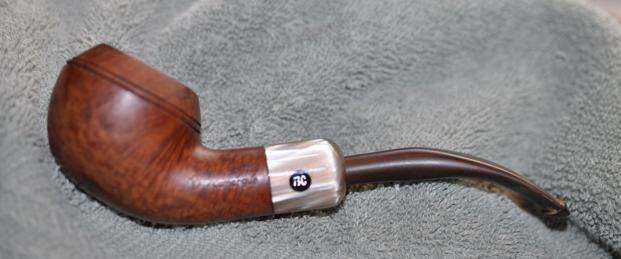
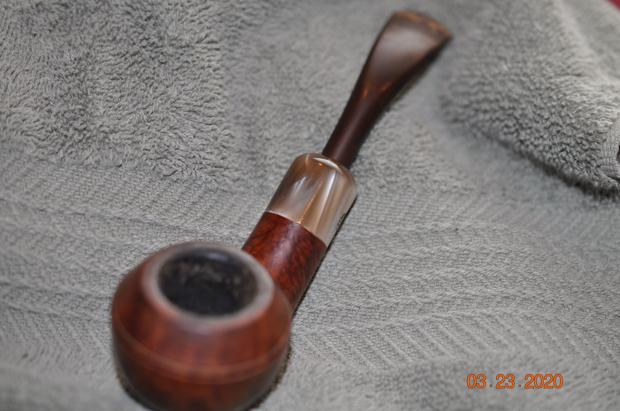 He took photos of the rim top to show the thick cake and the thick lava coat on the beveled edge and onto the top. It is hard to know what the condition of the rim top and edges is like under that thick lava. It is an incredibly dirty pipe but obviously one that was a great smoker. The shank extension looks good and is acrylic. The stem has tooth marks and chatter on both sides ahead of the button.
He took photos of the rim top to show the thick cake and the thick lava coat on the beveled edge and onto the top. It is hard to know what the condition of the rim top and edges is like under that thick lava. It is an incredibly dirty pipe but obviously one that was a great smoker. The shank extension looks good and is acrylic. The stem has tooth marks and chatter on both sides ahead of the button. 

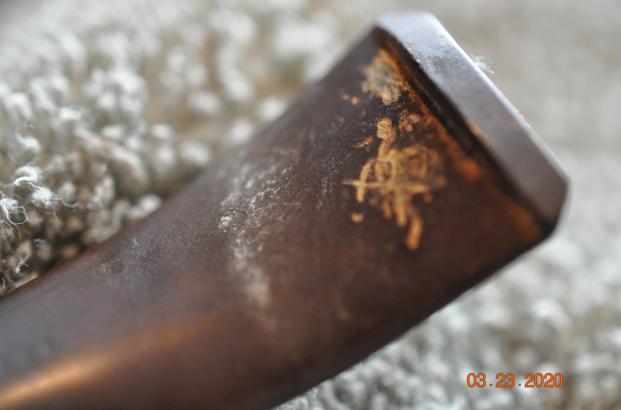 He took photos of the sides and heel of the bowl to show the beautiful grain around the bowl and the condition of the pipe. You can see the grime ground into the surface of the briar.
He took photos of the sides and heel of the bowl to show the beautiful grain around the bowl and the condition of the pipe. You can see the grime ground into the surface of the briar. 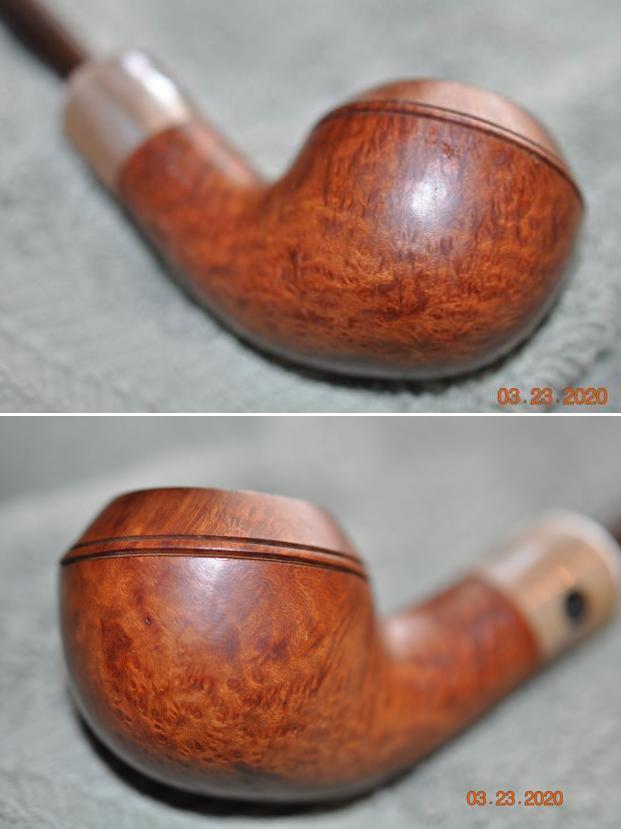
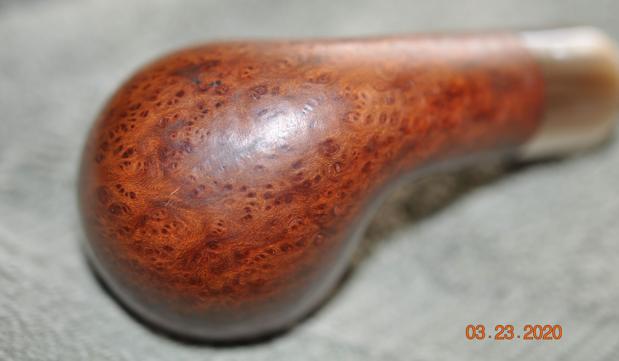 He took a photo of the stamping on the sides of the shank. It is clear and readable as noted above. He also captured the BC stamp on the shank extension.
He took a photo of the stamping on the sides of the shank. It is clear and readable as noted above. He also captured the BC stamp on the shank extension. 
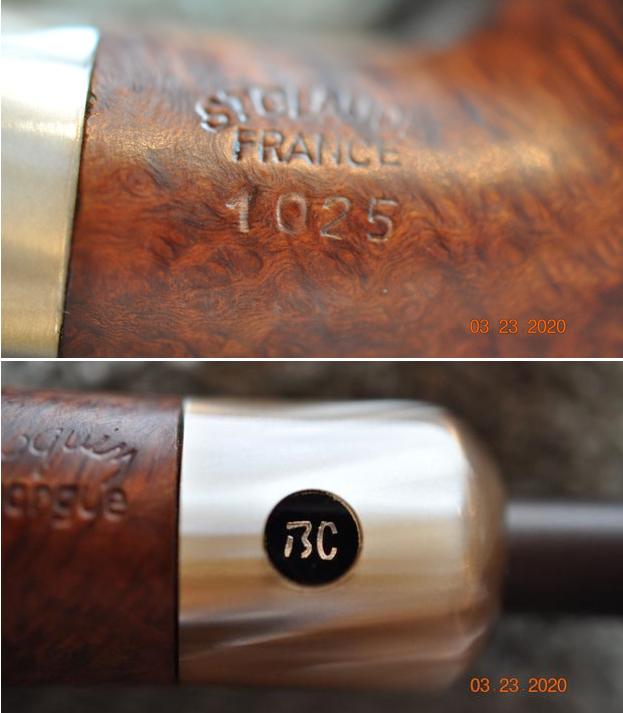 The shank extension was loose on the shank and had come unglued. It was filthy and the glue was dried and the extension came off. Jeff took photos of the parts.
The shank extension was loose on the shank and had come unglued. It was filthy and the glue was dried and the extension came off. Jeff took photos of the parts. 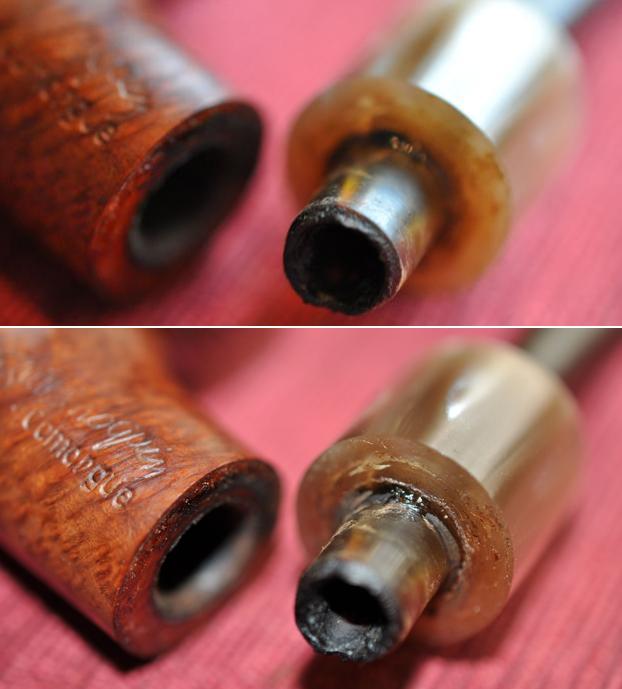
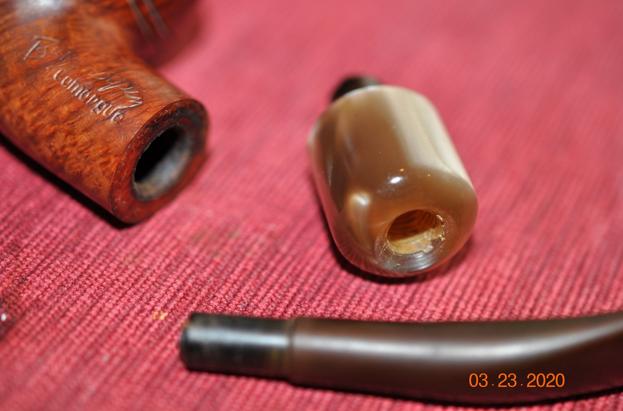 I remembered that I had worked on a Camargue pipe by Butz-Choquin before so I turned to the blog and did a search (https://rebornpipes.com/2020/10/24/fresh-life-for-a-butz-choquin-camargue-bent-rhodesian-sitter/). I quote from that blog and also from one that Dal Stanton wrote.
I remembered that I had worked on a Camargue pipe by Butz-Choquin before so I turned to the blog and did a search (https://rebornpipes.com/2020/10/24/fresh-life-for-a-butz-choquin-camargue-bent-rhodesian-sitter/). I quote from that blog and also from one that Dal Stanton wrote.
Dal Stanton had written a blog on his restoration of a Camargue pipe for rebornpipes in the past (https://rebornpipes.com/2019/12/04/rejuvenating-a-fancy-french-butz-choquin-camargue-1683-prince/). I turned to that now for a quick review of the history of the line. I quote:
I’ve worked on several Butz Choquin pipes which is based in the French pipe center of St. Claude. Here is a brief overview of the BC history from http://www.pipephil.eu/logos/en/logo-butzchoquin.html
The origin of the brand reaches back to 1858 when Jean-Baptiste Choquin in collaboration with his son-in-law Gustave Butz created their first pipe in Metz (France). Since 1951 Butz-Choquin Site officiel Butz Choquin, pipes de Saint-Claude Jura. BC pipe de bruyere luxe is a brand of the Berrod-Regad group (Saint-Claude, France).
Jean Paul Berrod managed the company from 1969 to 2002 when he retired and sold the corporate to Mr Fabien Gichon. Denis Blanc, already owner of EWA, took over the S.A. Berrod-Regad in 2006.
The BC line, ‘Camargue’ is not an old line as a simple search on the internet turns up several examples of classic pipe shapes with the ‘Camargue’ stamp, but unique to each is the acrylic shank extension and the military mounted stem. This example is a Dublin shape from (https://www.smokingpipes.com/pipes/estate/france/moreinfo.cfm?product_id=189826). Dal had also done some research on the name Camargue that I have included below. For me this kind of information adds colour to the restoration that I am working on.
Dal had also done some research on the name Camargue that I have included below. For me this kind of information adds colour to the restoration that I am working on.
…The name of the line, ‘Camargue,’ I discovered is a treasured nature reserve on the southern coast of France between Montpellier and Marseille – two beautiful venues which I’ve had the opportunity to visit. A Wiki article was very helpful in describing the area that this BC line is commemorating (https://en.wikipedia.org/wiki/Camargue).
With an area of over 930 km2 (360 sq mi), the Camargue is western Europe’s largest river delta. It is a vast plain comprising large brine lagoons or étangs, cut off from the sea by sandbars and encircled by reed-covered marshes. These are in turn surrounded by a large cultivated area.
Approximately a third of the Camargue is either lakes or marshland. The central area around the shoreline of the Étang de Vaccarès has been protected as a regional park since 1927, in recognition of its great importance as a haven for wild birds. In 2008, it was incorporated into the larger Parc naturel régional de Camargue.
The Camargue is home to more than 400 species of birds and has been identified as an Important Bird Area (IBA) by BirdLife International.[8] Its brine ponds provide one of the few European habitats for the greater flamingo. The marshes are also a prime habitat for many species of insects, notably (and notoriously) some of the most ferocious mosquitos to be found anywhere in France. Camargue horses (Camarguais) roam the extensive marshlands, along with Camargue cattle (see below).
The native flora of the Camargue have adapted to the saline conditions. Sea lavender and glasswort flourish, along with tamarisks and reeds… It was time to work on the pipe. As usual Jeff had done a thorough cleanup on the pipe. He reamed the bowl with a PipNet pipe reamer and followed up with a Savinelli Fitsall pipe knife to remove the cake. He scrubbed out the mortise and the airway in the shank and the stem with alcohol, cotton swabs and pipe cleaners. He scrubbed the exterior of the bowl, rim, shank and stem with a tooth brush and Murphy’s Oil Soap to remove the oils and tars on the rim and the grime on the finish of the bowl. He rinsed it under running water. One of the benefits of this scrub is that it also tends to lift some of the scratches and nicks in the surface of the briar. He dried it off with a soft cloth. He cleaned the internals and externals of the stem with alcohol, pipe cleaners and cotton swabs. He soaked the stem in Briarville’s Pipe Stem Deoxidizer and rinsed it off with warm water and cleaned out the airway in the stem with alcohol. This Rhodesian pipe actually was quite stunning!
It was time to work on the pipe. As usual Jeff had done a thorough cleanup on the pipe. He reamed the bowl with a PipNet pipe reamer and followed up with a Savinelli Fitsall pipe knife to remove the cake. He scrubbed out the mortise and the airway in the shank and the stem with alcohol, cotton swabs and pipe cleaners. He scrubbed the exterior of the bowl, rim, shank and stem with a tooth brush and Murphy’s Oil Soap to remove the oils and tars on the rim and the grime on the finish of the bowl. He rinsed it under running water. One of the benefits of this scrub is that it also tends to lift some of the scratches and nicks in the surface of the briar. He dried it off with a soft cloth. He cleaned the internals and externals of the stem with alcohol, pipe cleaners and cotton swabs. He soaked the stem in Briarville’s Pipe Stem Deoxidizer and rinsed it off with warm water and cleaned out the airway in the stem with alcohol. This Rhodesian pipe actually was quite stunning! 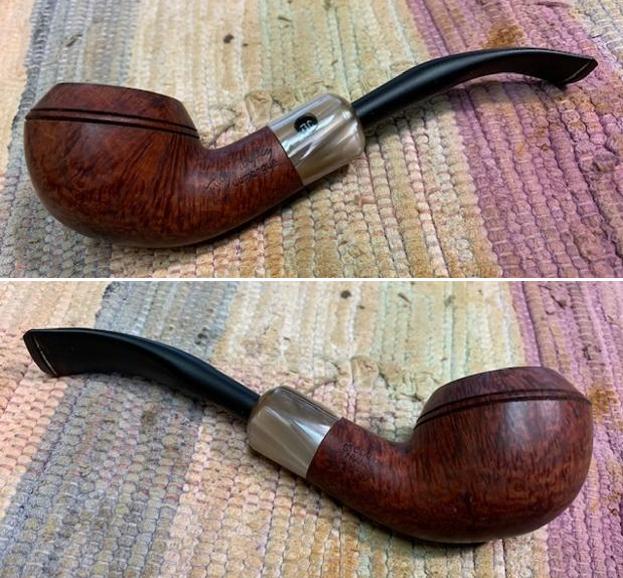
 I took a photo of the rim top and stem to show the condition. The rim top looked very good. There was some darkening on the rim top and the inner edge of the bowl. The loose shank extension would need to be aligned and glued. The vulcanite stem had light tooth chatter and marks on both sides ahead of the button and on the button edges.
I took a photo of the rim top and stem to show the condition. The rim top looked very good. There was some darkening on the rim top and the inner edge of the bowl. The loose shank extension would need to be aligned and glued. The vulcanite stem had light tooth chatter and marks on both sides ahead of the button and on the button edges. 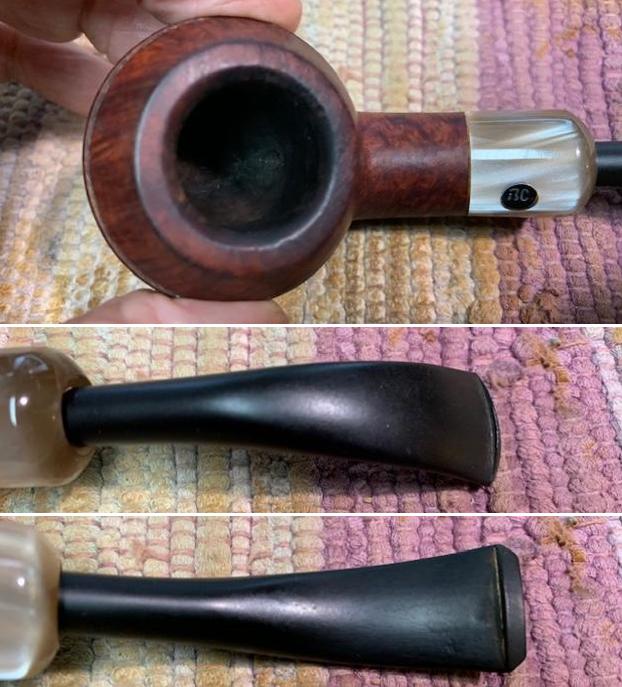 I removed the stem and the extension from the shank and took a photo of the pipe to give a sense of the whole. It is a nice looking pipe that should clean up very well. I aligned the extension in the shank and glued it in place with clear CA glue.
I removed the stem and the extension from the shank and took a photo of the pipe to give a sense of the whole. It is a nice looking pipe that should clean up very well. I aligned the extension in the shank and glued it in place with clear CA glue. 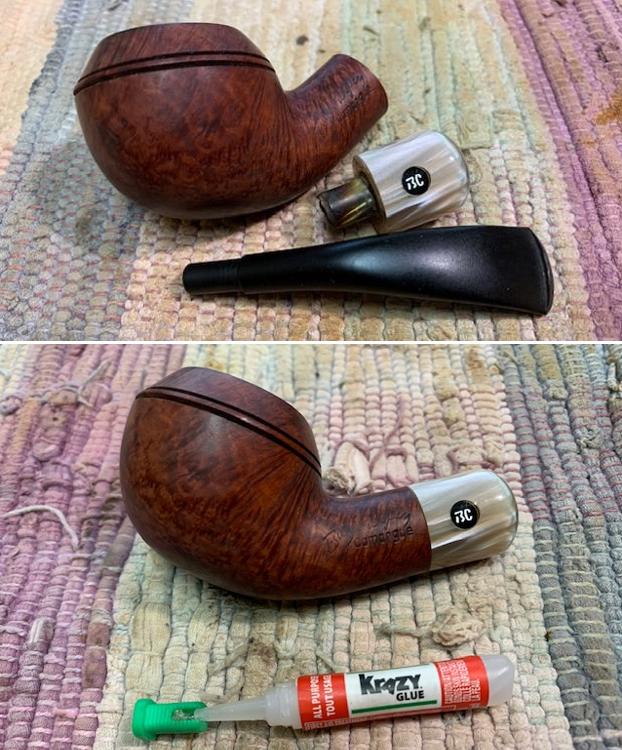 I polished the briar with micromesh sanding pads – wet sanding with 1500-12000 grit pads and wiped down the bowl after each sanding pad.
I polished the briar with micromesh sanding pads – wet sanding with 1500-12000 grit pads and wiped down the bowl after each sanding pad. 


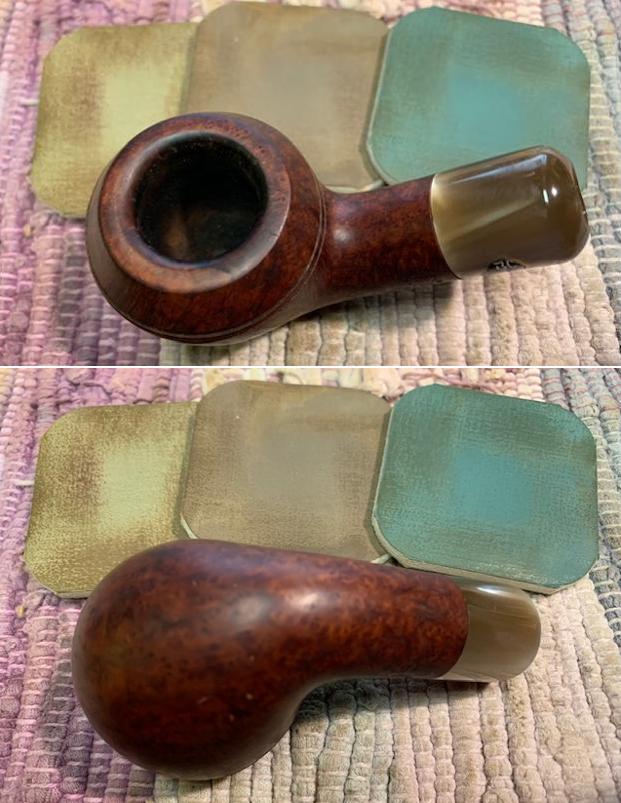

 I rubbed the bowl and shank down with Before & After Restoration Balm. I worked it into the surface of the bowl sides and shank with my fingertips. I worked it into the twin rings around the bowl cap with a horsehair shoe brush. The product works to clean, enliven and protect the briar. I let the balm sit for a little while and then buffed with a cotton cloth to raise the shine. The Balm did its magic and the grain stood out.
I rubbed the bowl and shank down with Before & After Restoration Balm. I worked it into the surface of the bowl sides and shank with my fingertips. I worked it into the twin rings around the bowl cap with a horsehair shoe brush. The product works to clean, enliven and protect the briar. I let the balm sit for a little while and then buffed with a cotton cloth to raise the shine. The Balm did its magic and the grain stood out. 
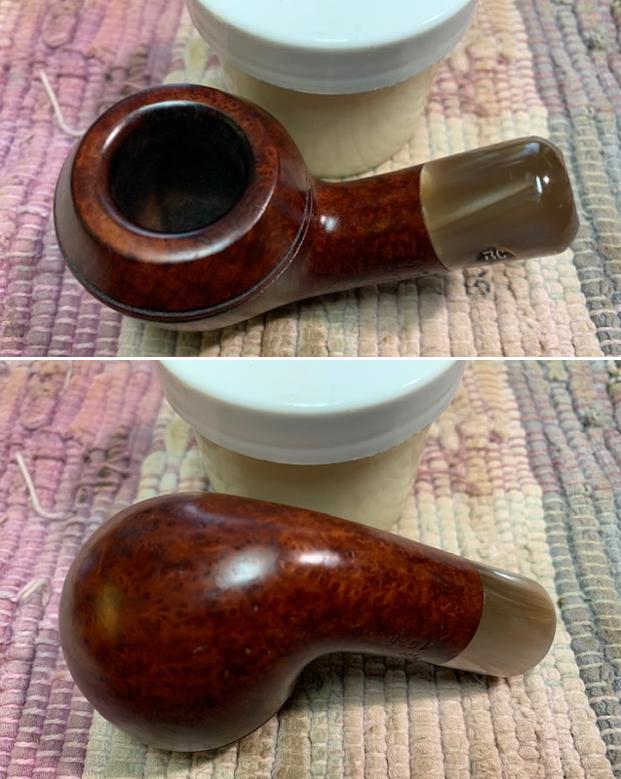
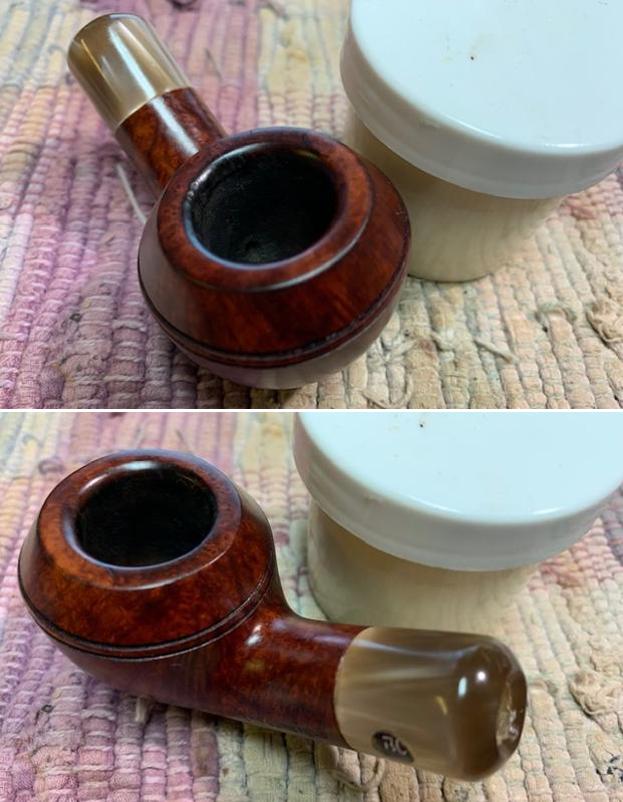 I set the bowl aside and turned my attention to the stem. I sanded the tooth chatter and marks with 220 grit sandpaper and started the polishing process with 400 grit wet dry sandpaper.
I set the bowl aside and turned my attention to the stem. I sanded the tooth chatter and marks with 220 grit sandpaper and started the polishing process with 400 grit wet dry sandpaper. 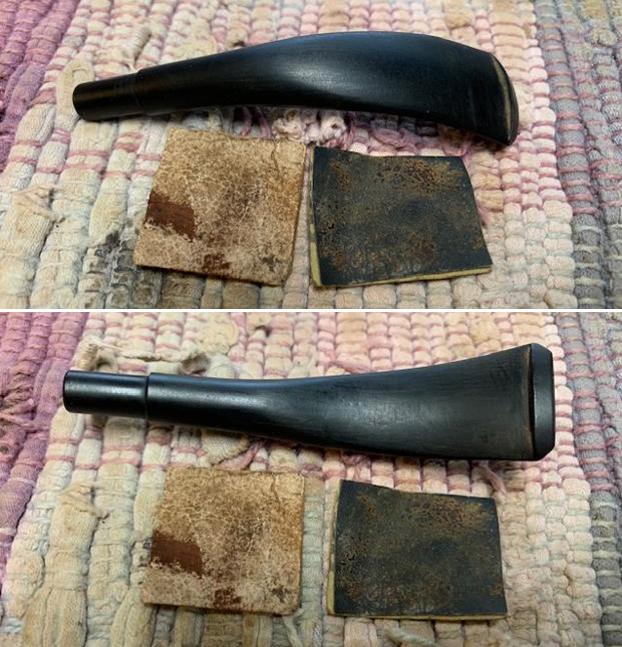 I polished the vulcanite stem with micromesh sanding pads – 1500-12000 grit pads. I wiped it down with Obsidian Oil after each sanding pad. I used Before & After Pipe Polish – both Fine and Extra Fine to further polish the stem. The photo below shows the polished stem.
I polished the vulcanite stem with micromesh sanding pads – 1500-12000 grit pads. I wiped it down with Obsidian Oil after each sanding pad. I used Before & After Pipe Polish – both Fine and Extra Fine to further polish the stem. The photo below shows the polished stem. 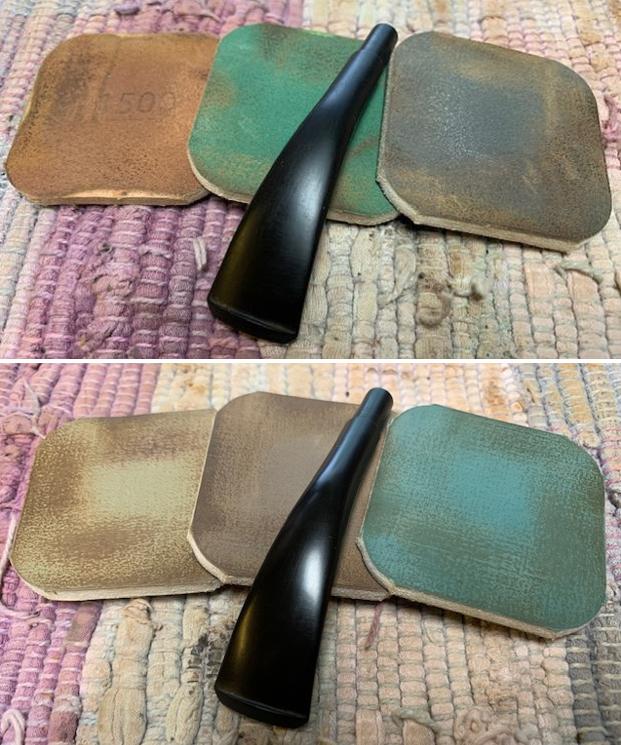
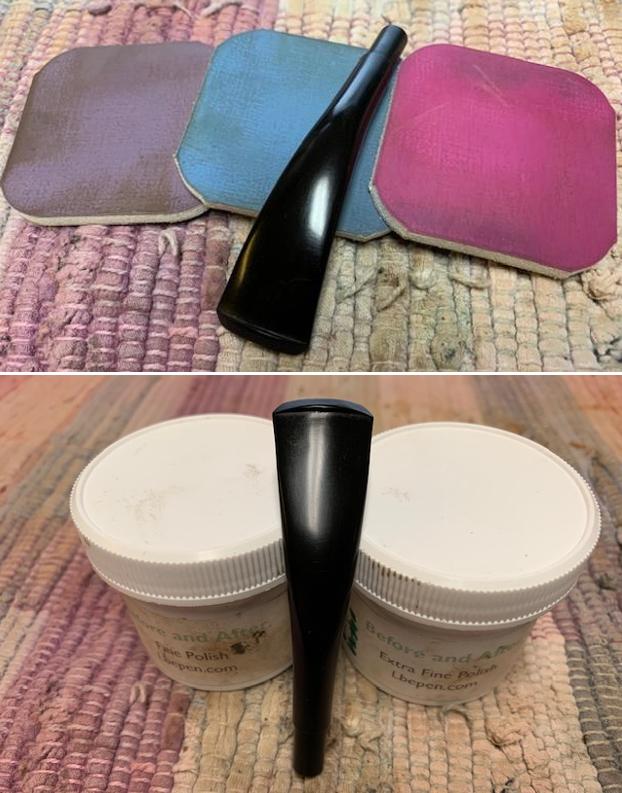 This nicely grained Butz Choquin Camargue 1025 Rhodesian with a vulcanite military bit stem is a great looking pipe now that it has been restored. The briar is clean and really came alive. The rich brown stains gave the grain a sense of depth with the polishing and waxing. The grain really popped. I put the vulcanite stem back on the bowl and carefully buffed the pipe with Blue Diamond on the buffing wheel using a light touch on the briar. I gave the bowl and the stem multiple coats of carnauba wax on the buffing wheel. I buffed the pipe with a clean buffing pad to raise the shine. I hand buffed the pipe with a microfiber cloth to deepen the shine. The finished Butz Choquin Camargue Rhodesian is a beauty and feels great in the hand and looks very good. Give the finished pipe a look in the photos below. The dimensions of the pipe are Length: 5 ¾ inches, Height: 1 ½ inches, Outside diameter of the bowl: 1 ¾ inches, Chamber diameter: ¾ of an inch. The weight of the pipe is 50 grams/1.76 oz. The pipe will be going on the rebornpipes store soon. It will be in the section on French Pipe Makes if you would like to add it to your collection.Thanks for reading this blog and my reflections on the pipe while I worked on it. There are many more to come!
This nicely grained Butz Choquin Camargue 1025 Rhodesian with a vulcanite military bit stem is a great looking pipe now that it has been restored. The briar is clean and really came alive. The rich brown stains gave the grain a sense of depth with the polishing and waxing. The grain really popped. I put the vulcanite stem back on the bowl and carefully buffed the pipe with Blue Diamond on the buffing wheel using a light touch on the briar. I gave the bowl and the stem multiple coats of carnauba wax on the buffing wheel. I buffed the pipe with a clean buffing pad to raise the shine. I hand buffed the pipe with a microfiber cloth to deepen the shine. The finished Butz Choquin Camargue Rhodesian is a beauty and feels great in the hand and looks very good. Give the finished pipe a look in the photos below. The dimensions of the pipe are Length: 5 ¾ inches, Height: 1 ½ inches, Outside diameter of the bowl: 1 ¾ inches, Chamber diameter: ¾ of an inch. The weight of the pipe is 50 grams/1.76 oz. The pipe will be going on the rebornpipes store soon. It will be in the section on French Pipe Makes if you would like to add it to your collection.Thanks for reading this blog and my reflections on the pipe while I worked on it. There are many more to come! 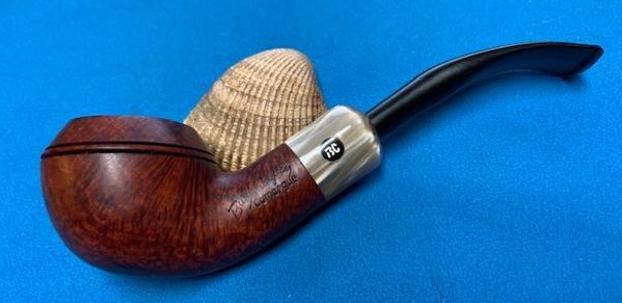



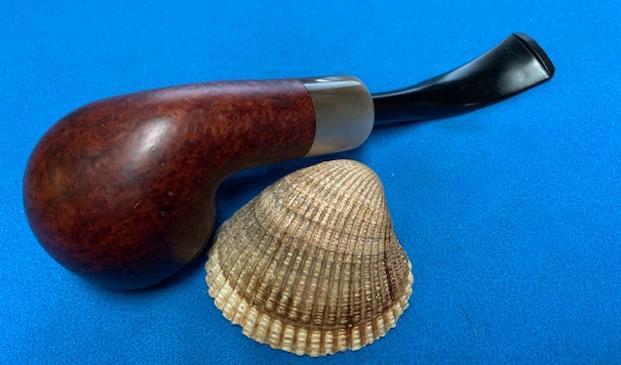
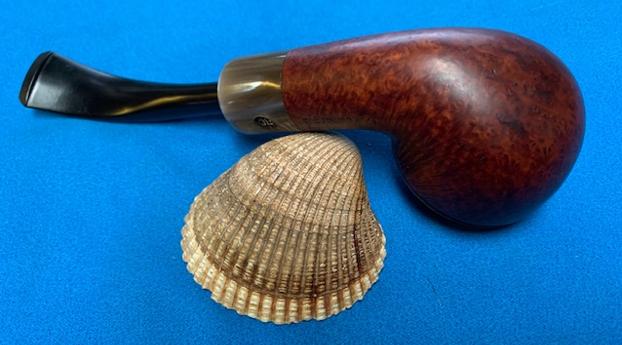
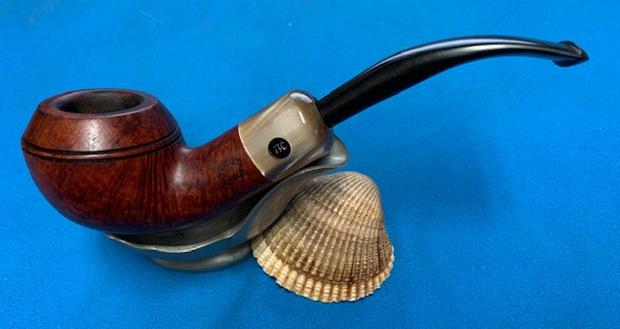
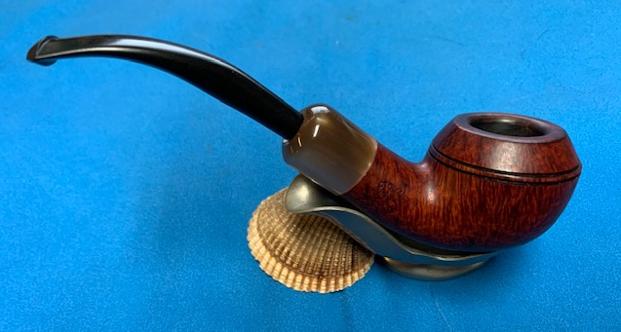
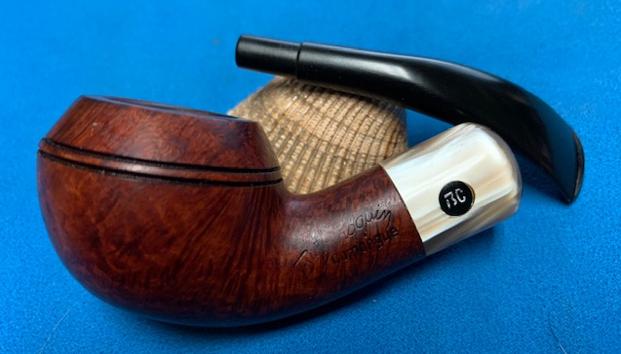




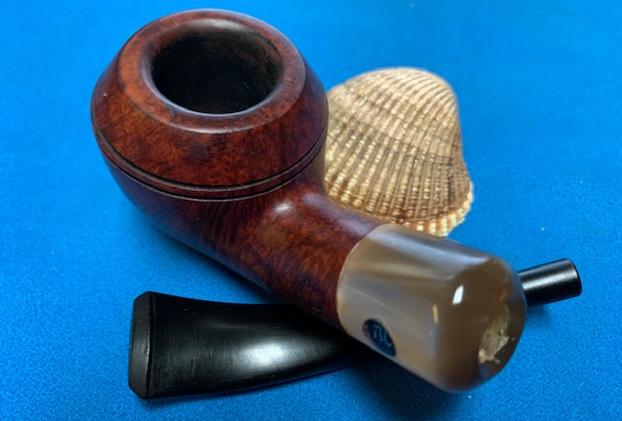

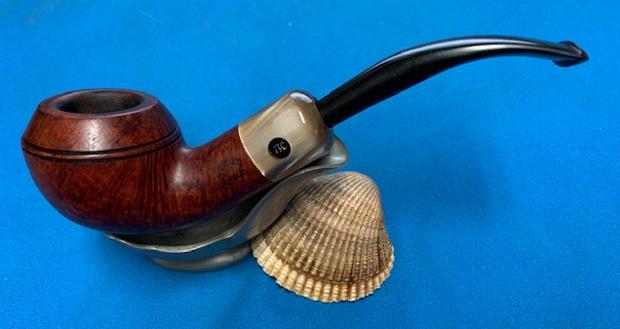
What a gorgeous pipe! Great work.
LikeLiked by 1 person